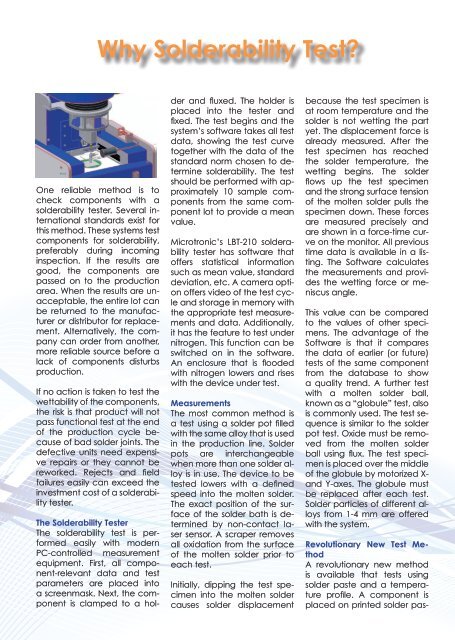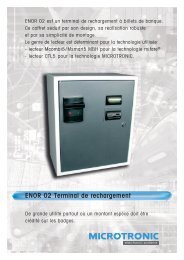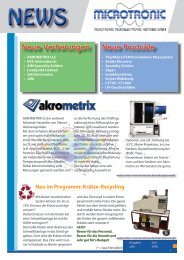Standards: Features - Microtronic GmbH
Standards: Features - Microtronic GmbH
Standards: Features - Microtronic GmbH
Create successful ePaper yourself
Turn your PDF publications into a flip-book with our unique Google optimized e-Paper software.
Why Solderability Test?<br />
One reliable method is to<br />
check components with a<br />
solderability tester. Several international<br />
standards exist for<br />
this method. These systems test<br />
components for solderability,<br />
preferably during incoming<br />
inspection. If the results are<br />
good, the components are<br />
passed on to the production<br />
area. When the results are unacceptable,<br />
the entire lot can<br />
be returned to the manufacturer<br />
or distributor for replacement.<br />
Alternatively, the company<br />
can order from another,<br />
more reliable source before a<br />
lack of components disturbs<br />
production.<br />
If no action is taken to test the<br />
wettability of the components,<br />
the risk is that product will not<br />
pass functional test at the end<br />
of the production cycle because<br />
of bad solder joints. The<br />
defective units need expensive<br />
repairs or they cannot be<br />
reworked. Rejects and field<br />
failures easily can exceed the<br />
investment cost of a solderability<br />
tester.<br />
The Solderability Tester<br />
The solderability test is performed<br />
easily with modern<br />
PC-controlled measurement<br />
equipment. First, all component-relevant<br />
data and test<br />
parameters are placed into<br />
a screenmask. Next, the component<br />
is clamped to a hol-<br />
der and fluxed. The holder is<br />
placed into the tester and<br />
fixed. The test begins and the<br />
system’s software takes all test<br />
data, showing the test curve<br />
together with the data of the<br />
standard norm chosen to determine<br />
solderability. The test<br />
should be performed with approximately<br />
10 sample components<br />
from the same component<br />
lot to provide a mean<br />
value.<br />
<strong>Microtronic</strong>’s LBT-210 solderability<br />
tester has software that<br />
offers statistical information<br />
such as mean value, standard<br />
deviation, etc. A camera option<br />
offers video of the test cycle<br />
and storage in memory with<br />
the appropriate test measurements<br />
and data. Additionally,<br />
it has the feature to test under<br />
nitrogen. This function can be<br />
switched on in the software.<br />
An enclosure that is flooded<br />
with nitrogen lowers and rises<br />
with the device under test.<br />
Measurements<br />
The most common method is<br />
a test using a solder pot filled<br />
with the same alloy that is used<br />
in the production line. Solder<br />
pots are interchangeable<br />
when more than one solder alloy<br />
is in use. The device to be<br />
tested lowers with a defined<br />
speed into the molten solder.<br />
The exact position of the surface<br />
of the solder bath is determined<br />
by non-contact laser<br />
sensor. A scraper removes<br />
all oxidation from the surface<br />
of the molten solder prior to<br />
each test.<br />
Initially, dipping the test specimen<br />
into the molten solder<br />
causes solder displacement<br />
because the test specimen is<br />
at room temperature and the<br />
solder is not wetting the part<br />
yet. The displacement force is<br />
already measured. After the<br />
test specimen has reached<br />
the solder temperature, the<br />
wetting begins. The solder<br />
flows up the test specimen<br />
and the strong surface tension<br />
of the molten solder pulls the<br />
specimen down. These forces<br />
are measured precisely and<br />
are shown in a force-time curve<br />
on the monitor. All previous<br />
time data is available in a listing.<br />
The Software calculates<br />
the measurements and provides<br />
the wetting force or meniscus<br />
angle.<br />
This value can be compared<br />
to the values of other specimens.<br />
The advantage of the<br />
Software is that it compares<br />
the data of earlier (or future)<br />
tests of the same component<br />
from the database to show<br />
a quality trend. A further test<br />
with a molten solder ball,<br />
known as a “globule” test, also<br />
is commonly used. The test sequence<br />
is similar to the solder<br />
pot test. Oxide must be removed<br />
from the molten solder<br />
ball using flux. The test specimen<br />
is placed over the middle<br />
of the globule by motorized X-<br />
and Y-axes. The globule must<br />
be replaced after each test.<br />
Solder particles of different alloys<br />
from 1-4 mm are offered<br />
with the system.<br />
Revolutionary New Test Method<br />
A revolutionary new method<br />
is available that tests using<br />
solder paste and a temperature<br />
profile. A component is<br />
placed on printed solder pas-





